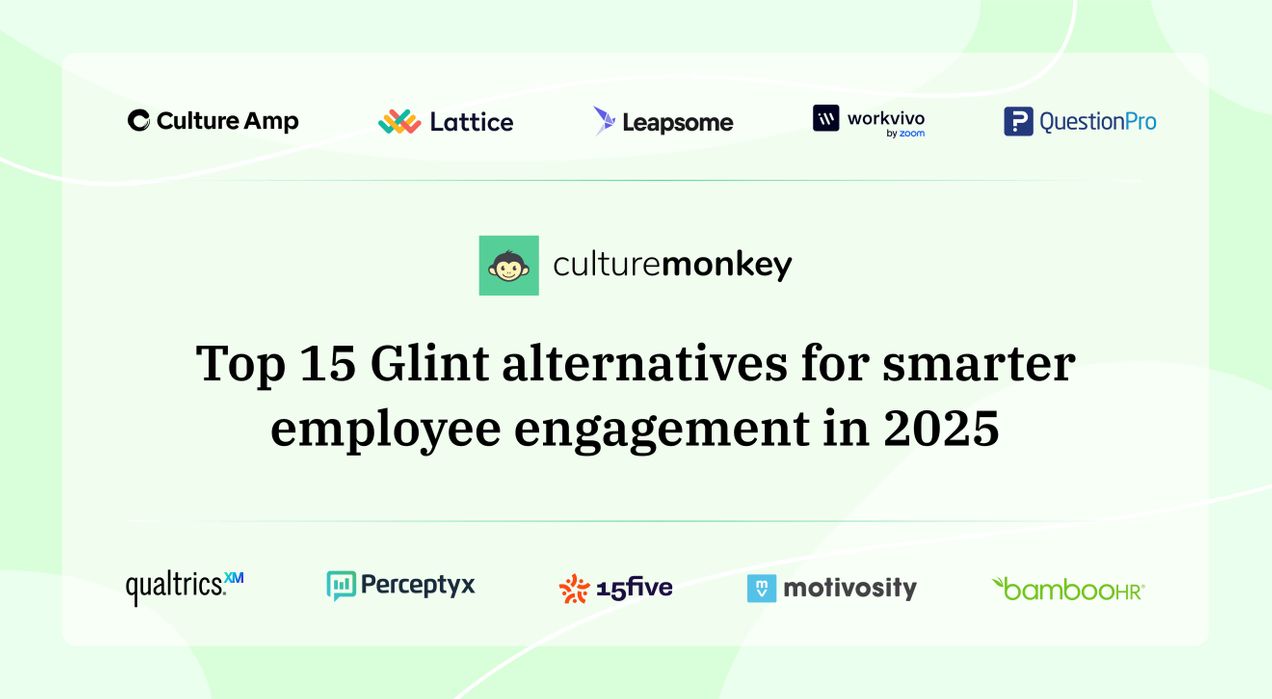Top 10 benefits of employee engagement survey in hybrid work

Remember trading mixtapes or burned CDs with friends back in the day? Each playlist felt like a window into someone’s world. That simple act taught you more about them than any small talk ever could.
Understanding the importance of employee engagement surveys and the benefits they bring works the same way. And with hybrid workplaces reshaping how people feel about their work, choosing the right approach, from full engagement surveys to quick pulse surveys, has never been more important to avoid employee dissatisfaction and raise employee engagement levels.
For leaders and managers, it’s about truly hearing what your people need as an engaged workforce with a culture of continuous improvement. Read on to know how these insights spark better decisions.
TL;DR
What is an employee engagement survey?

TL;DR
An employee engagement survey is a structured tool that measures how connected and motivated engaged employees feel. It helps leaders spot disengaged employees early, refine culture and motivation strategies, and use meaningful feedback to improve better business outcomes, retention, satisfaction, and overall workplace success.
An employee engagement survey is a structured tool to understand how connected and motivated your people feel at work. It defines the employee engagement survey purpose, helping leaders measure current engagement levels, spot areas where initiatives may be falling short, and refine strategies that keep teams inspired and committed.
Unlike generic staff surveys, a well-designed workforce engagement survey goes deeper. It captures how engaged employees experience company culture, leadership support, and day-to-day collaboration. By using smart employee feedback techniques, organizations can uncover early signs of disengaged employees and act before it turns into costly turnover or low morale.
Formats can vary. Some companies run short, recurring pulse surveys for quick insights, while others choose more detailed employee opinion surveys to gather richer, organization-wide engagement data. Both approaches give leaders the information they need to improve retention, motivation, and overall job satisfaction. It’s one of the key advantages of employee surveys, helping companies stay proactive about culture shifts.
Now that we know what an employee engagement survey is and why it matters, let’s explore the different types organizations can use effectively.
What types of employee engagement surveys can organizations use?

Imagine walking into a new office where everyone’s mood is a mystery. Some excited, some unsure and some ready to leave. Here’s the no-fluff takeaway: the right employee engagement survey helps decode these signals, showing the purpose of employee engagement survey design in action.
TL;DR
Employee engagement surveys include onboarding, exit, culture, team, job satisfaction, and pulse surveys. Each reveals insights on motivation, collaboration, and satisfaction, helping leaders identify cultural gaps, retention risks, and improvement areas to build stronger, more connected hybrid workplaces effectively.
- Onboarding surveys: Capture how new employees feel about their first days, reveal training gaps, and build loyalty from the start.
- Exit interviews: Uncover why employees leave and gather feedback to improve culture, retention, and future engagement strategies.
- Employee engagement surveys: Measure morale, motivation, and connection to the company to help managers boost team motivation and improve team engagement.
- Job satisfaction surveys: Understand what engaged employees value in their role and work environment to build long-term satisfaction and commitment.
- Pulse surveys: Run short, frequent check-ins to track engagement, well-being, and mental health throughout the year.
- Team surveys: Evaluate collaboration, trust, and alignment within teams to remove roadblocks and improve how people work together.
- Culture surveys: Reveal how engaged employees perceive company culture, whether they feel valued, and where leadership should act to strengthen engagement.
Once you know the types available, it’s important to understand the key benefits these surveys bring, especially in today’s hybrid work environments.
How do employee engagement surveys benefit hybrid workplaces?

Managing a hybrid workforce without feedback is like navigating with half a map. You know the roads but miss the turns. Put plainly, engagement surveys uncover the blind spots that keep teams connected, productive, and motivated across remote and in-office settings.
- Increases employee engagement: Understand how employees feel about their work and survey employee engagement trends, by creating initiatives that keep them motivated and productive.
- Builds stronger workplace relationships: Surface communication gaps, recognize contributions, and help teams feel respected and valued, fostering collaboration and trust.
- Reduces absenteeism: Detect early signs of disengagement, low motivation, or burnout and act quickly to improve satisfaction and cut down on missed workdays.
- Encourages transparent feedback: Provide a safe channel for employees to share honest views on policies, culture, processes and overall organizational performance, helping HR get feedback from employees consistently and make engagement data-driven improvements.
- Strengthens sense of belonging: Show employees their opinions matter, build loyalty, boost engagement and create an inclusive and positive company culture where people feel connected and valued.
- Monitors the employee life cycle: Track satisfaction and engagement at key stages such as onboarding, growth, and exit, to address retention risks early and foster a positive company culture.
- Reveals missing engagement drivers: Identify cultural gaps, misaligned goals, or lack of recognition so leaders can act on what matters most to employees.
- Boosts creativity and innovation: Gather ideas and feedback that inspire problem-solving, new approaches, improve employees' career development and a culture of continuous improvement.
- Improves work-life balance: Highlight needs around flexibility, benefits, and well-being support, enabling HR to design policies that prevent burnout.
- Enhances employee retention: Use insights on turnover drivers to build programs, recognition systems, and cultures that keep employees satisfied and committed.
These are some of the strongest employee engagement survey benefits, helping leaders take clear action on culture and performance. But running these surveys isn’t foolproof, let’s look at common mistakes companies make when measuring their impact.
What mistakes should you avoid when measuring employee engagement survey benefits?

Ever wondered why some teams gather plenty of feedback but see no real change? The short, data-backed truth: how you're measuring employee engagement matters as much as running the survey itself. Missteps here can quietly derail workplace progress and trust.
TL;DR
Common mistakes include focusing only on participation rates, tracking too many metrics, and ignoring qualitative feedback. Failing to segment data, compare relevant benchmarks, or follow up on survey results prevents meaningful action, leaving engagement surveys ineffective and employee trust damaged.
- Focusing only on participation rates: Measuring success by how many employees completed the survey without analysing the depth or quality of their responses leads to false confidence and limits the benefits of employee surveys, making them feel ineffective.
- Ignoring follow-up actions: Collecting feedback but failing to communicate changes back to employees damages trust and lowers future survey participation.
- Tracking too many metrics: Measuring every data point without clear priorities makes survey results hard to interpret and stops leaders from acting quickly.
Pulse surveys alone are enough to track employee motivation and culture.
Pulse surveys capture quick updates, but pairing them with full engagement surveys provides the depth needed for long-term culture and retention strategies.
- Overlooking qualitative insights: Relying only on numbers can miss critical stories and patterns that explain why engagement rises or falls.
- Comparing against irrelevant benchmarks: Using industry data that doesn’t match your company size, culture, or region can lead to misleading conclusions.
- Running surveys too infrequently: Measuring engagement only once a year misses changes in employee satisfaction, well-being, and motivation in fast-moving hybrid workplaces.
- Failing to segment data: Segmenting responses also helps employee engagement companies and HR teams design targeted improvements.
Avoiding these missteps is key, but designing a great survey matters just as much. Here’s how to do it right.
How do you effectively conduct an employee engagement survey?

Imagine asking for feedback but getting silence. It’s usually because employees fear being exposed or ignored. The fastest way to understand this is to design employee engagement surveys that feel safe, focused, and acted upon. Understanding how to get feedback from employees is key and employee surveys work when they feel safe, focused, and actionable.
TL;DR
Effective employee engagement surveys ensure anonymity, stay short and focused, and ask relevant, meaningful questions. Including open-ended feedback and offering small incentives encourage honest participation and higher response rates.
Analyzing survey results, identifying trends, and clearly communicating actions taken build trust, improve employee satisfaction, and turn survey data into impactful workplace change.
- Ensure responses stay anonymous: Use secure online tools or a third-party vendor so employees feel safe sharing honest feedback without fear of retaliation.
- Keep the survey short and focused: Limit questions to key areas like employee satisfaction rates, team engagement, and workplace culture to avoid survey fatigue.
- Ask unique and relevant questions: Tailor questions to your company’s context — job satisfaction, management effectiveness, and team collaboration — instead of generic or intrusive queries.
- Include open-ended questions: Allow employees to share detailed feedback, ideas, and concerns beyond simple yes/no or scale ratings.
- Offer incentives for participation: Small rewards such as gift cards, flexible hours, or recognition can boost response rates and show that employee feedback matters.
- Analyze and act on survey results: Review trends, identify areas needing improvement, and communicate changes to improve engagement and employee satisfaction.
These practices maximize the advantages of employee surveys and create measurable impact. Once you know how to conduct surveys well, the next step is choosing the right type — full engagement surveys or quick pulse surveys.
Engagement surveys vs pulse surveys: Which delivers better insights?

According to HR Cloud, 20% of employees are truly engaged at work, while 30-40% remain disengaged across industries. At its core, the answer is simple. Choosing the right mix of full engagement surveys and quick employee engagement pulse survey tools helps leaders uncover why employees feel disconnected and take action before disengagement spreads in hybrid workplaces.
| Aspect | Engagement surveys | Pulse surveys |
|---|---|---|
| Depth | Provide a detailed view of employee motivation, culture, and satisfaction across the organization. | Offer quick snapshots of employee morale and well-being for immediate insight. |
| Purpose | Shape long-term employee engagement strategies and clarify the employee engagement survey purpose with structured feedback and cultural insights. | Identify and solve short-term engagement issues before they grow. |
| Data scope | Capture broad, organization-wide employee feedback annually or semi-annually. | Gather frequent, focused pulse feedback to track changing needs. |
| Benchmarking | Enable year-over-year comparisons and external industry engagement benchmarks. | Reveal trends and shifts in employee sentiment in real time. |
| Resources | Require planning, analysis, and time but deliver deep employee engagement valuable insights. | Lightweight, flexible, and easy to deploy with minimal HR resources. |
| Employee insight | Reveal the big picture of engagement drivers and overall culture health. | Keep a running pulse on employee needs in hybrid workplaces. |
Many employee survey companies now combine annual engagement surveys with modern pulse survey technology to keep data fresh and actionable. Far from outdated, modern tools make surveys smarter and more actionable. Here’s how CultureMonkey leads the way.
Aren’t engagement surveys outdated in today’s fast-moving workplaces?
It’s tempting to think that employee surveys no longer matter when you can get instant reactions from chat tools or quick polls. But the numbers tell a different story. According to Gallup, employee engagement in the U.S. fell to its lowest level in a decade in 2024, with only 31% of employees engaged and 17% actively disengaged, matching lows last seen in 2014.
The drop has been sharpest among younger workers. This decline proves that surface-level check-ins aren’t enough; organizations need structured, data-rich feedback systems to spot deeper issues early and respond effectively.
How CultureMonkey makes employee engagement surveys smarter and actionable
Picture this: you spend weeks creating a staff survey, finally collect responses, and end up with a long spreadsheet nobody knows how to use. The fastest way to understand this is that CultureMonkey turns employee engagement pulse survey tools and scattered employee feedback into clear, actionable insights with no more guesswork, no more wasted effort.
- Easy-to-build employee surveys: Create employee engagement surveys, pulse surveys, or employee opinion surveys in minutes with ready-made templates and flexible customization.
- Advanced analytics: Move beyond basic participation rates with detailed engagement scores, sentiment trends, and cultural heatmaps that highlight real problem areas.
- Smart segmentation: Break down results by department, role, location, or tenure to understand unique employee needs and avoid one-size-fits-all fixes.
- Action-driven recommendations: Get AI-powered suggestions and feedback techniques to address low motivation, poor workplace culture, or retention risks quickly.
- Continuous listening: Run frequent pulse surveys alongside workforce engagement surveys to stay connected with shifting employee sentiment in hybrid workplaces.
- Real-time reporting: Share insights with leadership instantly through dashboards, helping HR teams and managers turn feedback into change fast.
Conclusion
By following these tips, businesses can effectively conduct employee benefits survey and use the data to create a more positive and productive workplace.
Workplace engagement is a two-way street that needs their participation as well. Thus, pay attention to your employees, comprehend their necessities, make them feel respected, and provide a helpful and cooperative atmosphere where they should be eager for business success.
Organizing regular employee engagement surveys for the workplace is a great way to ensure that it is engaged and part of a successful team. This facilitates the formation of a collaborative culture and motivates happy employees to take the initiative and generate fresh concepts.
Choosing platforms like CultureMonkey for surveying employees, helps HR leaders to understand how to engage a team at work and sustain long-term employee engagement benefits. We offer employee engagement surveys, employees' pulse score, and employee life cycle surveys to enhance your operations with the combined feedback of your workers.
We help you strengthen your company culture by providing an easy-to-use dashboard to share consistent feedback, recognize accomplishments, and build a cooperative work atmosphere.
Contact us to book a demonstration on how we can assist you in improving your workplace.
FAQs
1. What are the benefits of employee engagement surveys?
Employee engagement surveys give leaders actionable insight into motivation, satisfaction, and workplace culture. By using proven employee feedback techniques, these staff surveys highlight hidden challenges, track morale trends, and help design strategies that boost productivity, loyalty, and well-being. They empower HR to make data-driven decisions, improve employee motivation, and build a more connected, resilient workforce.
2. How do engagement surveys improve retention?
Workforce employee surveys uncover why employees disengage or consider leaving. They reveal gaps in recognition, growth, and culture that drive turnover. When leaders act on this feedback with meaningful changes, employees feel valued and supported. Over time, this strengthens trust, reduces attrition, and helps organizations keep their best talent committed even in hybrid workplaces.
3. Why are employee engagement surveys important for HR leaders?
Employee opinion surveys provide HR leaders with clear, data-backed insights into morale, workplace culture, and engagement drivers. These insights guide smarter policies, development programs, and leadership decisions. By understanding what truly matters to employees, HR can tackle disengagement early, improve employee motivation, and reduce costly turnover while building a stronger, future-ready workforce in fast-changing, hybrid work environments.
4. What business outcomes come from employee engagement surveys?
Well-run employee engagement surveys lead to measurable results: higher productivity, stronger loyalty, and reduced absenteeism. They also inform smarter leadership choices around culture, communication, and growth. By improving motivation and workplace satisfaction, these surveys directly support long-term organizational success, better innovation, and resilient hybrid workplaces where people stay committed and help the business achieve sustained performance.
5. Employee engagement surveys vs pulse surveys: What’s the difference?
Employee engagement surveys provide deep, strategic insight into culture, satisfaction, and long-term engagement, while pulse surveys offer quick, frequent snapshots of real-time sentiment. Combining both creates a balanced feedback system: engagement surveys guide big-picture strategy, and pulse surveys help track immediate morale shifts. Together, they give leaders accurate, actionable understanding of workforce engagement across hybrid environments.



